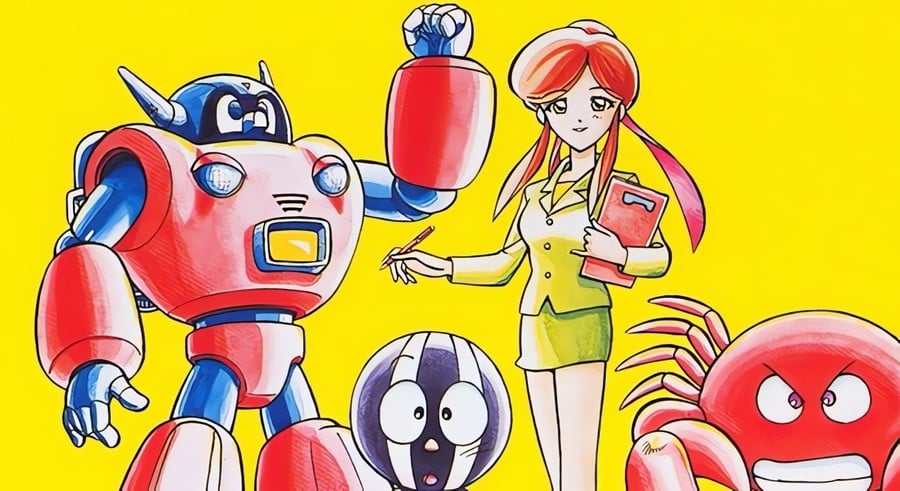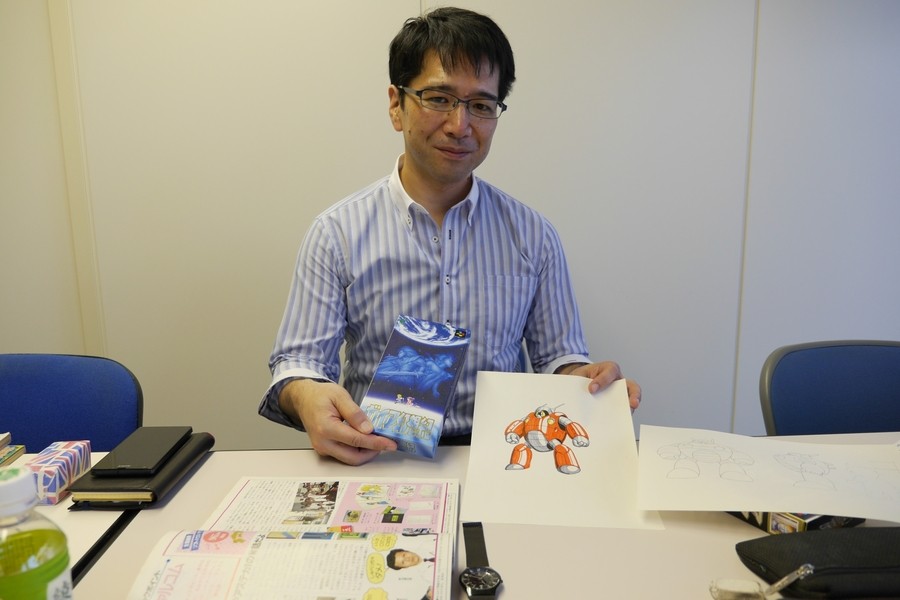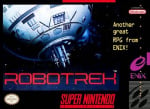
At Time Extension we love to look over old magazines, as evidenced by various features we've done on Super Play, Mean Machines and others. While espousing the positives, it's also worth casting a critical eye over some of the missteps magazines have made. Not to mock, but to understand some of the long-term effects a lazy review or false piece of news might have. Today's case: why Robotrek on the SNES deserved better.
When living in Japan to conduct interviews for The Untold History of Japanese Game Developers, I had the good fortune to meet Kouji Yokota on two occasions. His career is so extensive a third meeting would been nice; Yokota worked on classics at Telenet, Falcom, Game Arts, plus Quintet, and his portfolio includes Valis, Megami Tensei, Exile, Ys III, Dragon Slayer, Gaiares, Lunar: Eternal Blue, ActRaiser, Soul Blazer, Illusion of Gaia, and Robotrek.
Phew! That is a lot of highly acclaimed games, so you know how precious each minute of dialogue was. What wasn't so acclaimed was Robotrek, with most magazines dismissing it. Super Play scored it 72%, saying it's a standard and average RPG which doesn't do anything original. Electronic Gaming Monthly gave an average score of 7, its micro-review saying it's geared towards younger players. Super Gamer scored it a respectable 82%, but again said it does nothing original - with the reviewer describing it as a kids' introduction to RPGs which won't interest experienced players. GamePro scored it 13 out 20, though did at least acknowledge it's trying to push the envelope.
The only magazine to champion Robotrek in any way seems to have been Diehard GameFan; they didn't evaluate it as part of the Review Crew, but in a preview page, Nick Rox described it as totally different and refreshing, while lamenting the fact it would likely be ignored in favour of Final Fantasy III.
I had not read GameFan's preview, nor had I played Robotrek, so I entered the conference room carrying all the baggage from those other magazines. While Yokota showed off the designs he did for Robotrek, saying it was embarrassing to be photographed, I asked a few questions out of politeness, keen to move on to Quintet's other games. Actraiser, Soul Blazer, and Illusion of Gaia were three all-time favourites on the SNES, and Yokota was involved in all three. Yokota hadn't worked on Terranigma, but I was in contact with its planner, Takeshi Tsuru, who promised to contact former colleagues, and almost resulted in a group Terranigma interview (lack of time curtailed these plans).
John Szczepaniak: Let's talk Quintet. Could you briefly tell me your role on ActRaiser, Soul Blazer, Illusion of Gaia, Robotrek, Terranigma, and I believe you were in charge of Granstream Saga?
KY: [...] For Robotrek I was doing the design for the robots.
JS: When you say robot designs, were you sketching them on pieces of paper?
KY: Yes. <shows sketches>
JS: I'd love to get a few photographs of you holding your work.
KY: <laughs> It's embarrassing! OK. You know, I'm very embarrassed. <referring to robot designs> The request was to design something quite retro, or old fashioned rather.
JS: Are you aware of the following Quintet has outside Japan?
KY: I didn't know that.
JS: Your games are well loved. I think if you visited a game convention, a lot of people would want your signature.
KY: <laughs> I don't think so! I think you are exaggerating!
JS: Not at all! <turns to Joseph Redon of the Japanese game Preservation Society> Am I exaggerating, Joseph?
JR: No! <laughs>
JS: However, Terranigma came out in Europe but not America. There were exceptions.
KY: No, for some reason not in the United States. When Quintet came up with Terranigma, that is when Shade was established.
JS: That's why you were not involved with it?
KY: That's correct. You emailed me saying that you were going to interview Mr Takeshi Tsuru; he was involved with Terranigma. Have you already interviewed him?
JS: He was going to contact colleagues and we were going to have a joint interview. Fans regard Soul Blazer, Illusion of Gaia, Terranigma, and Granstream Saga, as a loosely connected four-part saga.
KY: Yes, I think there was a common custom or thread shared among the games, in terms of scenario writing, such as like the delivery of the dialogue, and so on. So in that effect I think there was some resemblance. Starting with ActRaiser, and followed by Soul Blazer and Illusion of Gaia, the games are definitely connected, in Miyazaki-san's mind at least. Whereas Terranigma and Granstream Saga are somewhat different. Because I was the one who came up with the basic idea for Granstream Saga. I don't know about Terranigma though.

JS: I suppose when someone likes all the games from a company, they want to draw connections.
KY: Yes. I can understand that, because as a fan it's exciting to discover connections or relationships between the characters and contents of the games. [...] I think Miyazaki-san [Tomoyoshi Miyazaki] became very popular because he was able to come up with a convincing script, incorporating pathos, or a kind of sadness into it.
JS: In contrast, Robotrek was quite light-hearted.
KY: Yes. The reason is because one of the planning staff was a woman, she used to belong to Falcom as well, and she was involved in a game called Dinosaur. Well, Dinosaur was quite dark, so she wanted to do something completely different and come up with something very fantastical and light, so that is why she came up with this new game, Robotrek. She intentionally made it light and happy with a pop sensibility. The game involves an inventor, but they didn't want it to be about cutting-edge technology. So they aimed for a more approachable and endearing, somewhat retro atmosphere, and outsourced the scenario and character design to us with that kind of world in mind. So I created the robot designs based on that.
JS: With a kind of an old fashioned feel.
KY: That's correct. <brings out photo> I found a couple of photographs of me and Miyazaki-san, from Quintet. This is the picture taken at the Quintet office back then.
JS: Amazing! Can I photograph these?
KY: Yes, of course. We were both very young. [...] The office is not looking so clean or tidy.
And there you have it. The extent of our Robotrek discussion.
Then about two years ago, I decided to play through Quintet's entire 16-bit oeuvre, on real hardware, plus Granstream Saga, in semi-chronological order. It took about two years to work through all of them, and the experience was glorious. Actraiser, Soul Blazer, and Illusion of Gaia are works of pure artistry. ActRaiser 2 was so difficult, and formulaic, that a longplay video sufficed. Terranigma was interesting but poorly paced, only getting great once past the halfway mark when people had returned to the world. The opening dungeons are also one of the longest tutorials in gaming.
Granstream Saga, meanwhile, turned out to be disappointing – confusing layouts without a map, and repetitive combat which drags on forever due to enemies blocking 99% of your attacks, even with the strongest sword! It, too, was quickly substituted for a longplay video. Robotrek was left until last, simply because the reviews said it was "unoriginal" and "you know, for kids".
Imagine my horror then to discover that not only is Robotrek extremely innovative, for multiple reasons, but it's one of the best games by Quintet, and one of the best games on the SNES. It's also mechanically complicated and quite challenging. If you've not played it, and have only read magazine coverage, you might be thinking this is a contrarian viewpoint for the sake of it. A quick search on Twitter though reveals other fans, all pointing out how underrated it is. The magazines of the time just didn't give it a chance.
So, What Is Robotrek About?
The dichotomy between magazines claiming it tries something new and those saying it's unoriginal is interesting. Since right from the start Robotrek is mechanically distinct. Here's where playing the original boxed copy helps, since anyone emulating will have missed out on the manual and special poster explaining the more complicated aspects.
Over the course of the game, you acquire three robots which you can name and colourise, and then program with special attacks based on what's equipped in the robot's hands and backpack (called Run Commands – geddit? Because computers "run" programs). For example, putting a gun in the left hand, and sword in right, and then programming a Run Command attack of RLL results in your robot dashing to each enemy in the three rows and attacking them (basically a devastating attack all move).
Other combinations incorporate X if you've equipped a bomb to their back. There are 19 combinations using the above. In addition to swords, guns, and bombs though, there are axes, blades, hammers, celtis, punch gloves, blow fists, and lasers. That's just for attacking. There are also shields and boots, and special backpacks that do things like recharge health. Hand items can be put in any hand (dual-wielding even!), and this can change the way run commands work. Also, did I mention you can name each programmed attack anything you like? (I named them all after food.)
Also, of the above weapons, there are three or four varieties, denoting power. But each of these has 9 levels, which increase through use. Sword 1 Level 9 is more powerful than Sword 2 Level 1, for example. Oh, and you can combine weapons of the same type, whereupon it recalculates a new level and power. In fact, there's a fairly robust crafting system where you can combine common and rare items to make all sorts of things (Top Tip: A weather item and an empty pack give you the solar pack). If you don't want to craft items, you can just make them, after finding and reading various instruction books dotted around. Today crafting in games is commonplace, but how often did you see it in a console game in 1994?
Hopefully, you found all of the above slightly bewildering. Not to say the game is confusing, since it eases you in gently, but to show it's anything but a beginner's introduction to the genre. The game expects you to use the above systems extensively, with enemies having weaknesses and bosses being tough unless you exploit said weakness. I died in boss battles a few times until I changed strategies, after which they were easy. I've not even covered the attack hotkeys, item attacks, or the fact none of the battles are random since you see every enemy – this was another innovation for 1994, when random encounters were the norm.
Also, your robot's parameters can be altered at any time. Levelling up earns you more computer memory (measured in megs), which you can distribute to attack, defence, and so on. You can visit a workshop and reset everything, thus radically changing how a robot functions, and you can also do this with each level up. Of your three robots each can be customised for specific uses: the tank, the agile mover, the critical hitter, the immortal defender who duel wields shields and revives the others – whatever you want. Each also has a hidden 20% stat boost which makes them adept at specific tasks. If online reports are accurate: for the first robot, it's Power; for the second, it's Guard, and for the third, Speed.
The game also has quick saving. You're given a walkie-talkie at the start to call Nagisa (a robot built by your dad to resemble your mother), and you can save almost anywhere. There are a few rooms which contain cut-scene triggers, and you can't save in these, but otherwise, you can quick save or quick load at any time. Again, how often did you see this on consoles in 1994? A good strategy is to save just before you get enough XP to level up, attempt the boss, and if you lose, reload, level up, then remake your robots to better tackle the boss.
Criticism regarding the story being generic or unoriginal is also bizarre, because while most other JRPGs of the time had a sword & sorcery theme, with dragons et al, Robotrek is more akin to EarthBound, with a modern setting, computers and the internet (sort of), goofy aliens, tropical islanders, an immortal vampire (named Belmont, of course!), the ability to talk to animals, time travel, space travel, robots (of course), and bizarre existential dialogue on the size of a crab's brain. Does a crab have feelings? You betcha! You even have to phone one of your parents (kinda), like EarthBound, to save. It's a little surprising actually that the EarthBound community hasn't picked up on the similar tone. If you loved any of the Mother / EarthBound games, you'll probably like Robotrek, too.
There is so much wonderful attention to detail. When you travel back in time, there's an optional side-quest to reconcile a longstanding feud between two families, so the kids are free to fall in love untroubled. Also, if you change your appearance for the commemorative photo, this shows up later in the present. The town bulletin board has new items pop up as the story progresses. In your father's garden is a birdhouse, and over the course of the game, an egg will be laid, will hatch, and the bird will grow and then depart. Meanwhile, hidden under your father's bed is his old diary, describing how he built Nagisa after his wife died, so you wouldn't notice your mother was gone. (Is that a bit of dust in your eye? It's OK, take a moment.) You can also use a key item to talk to dogs, cats, and chickens – not for any specific reason, just for fun.
These key items deserve special mention. In regular RPGs, they tend to be single-use, for obvious lock-and-key puzzles. You find them in a separate menu labelled "key items", and that's all they're used for. In Robotrek, key items will be used to progress at specific points but also have secondary functions. For example, the glasses will show invisible enemies. Or the cyberjack item, needed to reach a computer virus boss, can be used on the computer in your home to access a hidden developer room and chat with Quintet staff. You're encouraged to experiment to discover neat things easily missed.
It's interesting that Yokota cites part of the reason for the game's light-hearted nature as being because Reiko Takebayashi was a woman. At Time Extension, we champion the role of women in games, with many of our favourite games being female-designed. Some might argue it's stereotyping to say a woman brought cuteness to a game's design, but then... you look at the words of the all-male reviewers in EGM, where they say they "wish there was a harsher tone to the whole thing." For context, the staff of EGM had the following in their personal top 10 that month: Samurai Shodown II, The King of Fighters '94, Demon's Crest, and Doom. All undeniable classics, yes, but one can't help but feel that maaaaaybe all that high-octane action numbed them to something a little more silly and whimsical? And they weren't even playing the Japanese version, titled Slapstick, which is even cuter - just look at the art for the enemies, they're adorable!
Thankfully, there's a translated interview with Reiko Takebayashi online, courtesy of James Wragg. The interview is from the Slapstick Challenge Book, and to quote a small portion, Takebayashi says:
The idea was born from the desire to make a game where the player created something and nurtured it. This in turn led to the inventor / robot idea. The original system was actually based on the concept that the hero would invent robots with varied abilities and these robots would then help the townspeople with their daily lives. I'm confident that every player will be able to find their own way to enjoy the game; from the setting of special attacks to combining items.
Sadly, my interview with Kouji Yokota cannot be redone, and to this day, I regret not exploring the topic of Robotrek more. The failing, of course, is mine, for not exploring his entire portfolio thoroughly regardless of what others said – but a part of me also feels that magazines of the time should shoulder some of the responsibility since their lacklustre reviews contributed to poor sales, a general lack of community interest, and ultimately one journalist dismissing it in favour of discussing other games.
Not long ago, there was a story on Yuzo Koshiro wanting Illusion of Gaia and Terranigma remakes. After all, Actraiser was remade in 2021. Imagine, though not a remake, but a Quintet compilation containing its 16-bit works? Quintet means five, so you could have the five aforementioned classics: Actraiser, Soul Blazer, Illusion of Gaia, Robotrek and Terranigma.
Call it the Quintet Pentalogy. Given how overlooked and underrated Robotrek is, there might be the temptation to leave it out. But this would be a mistake. Robotrek is so good, for so many reasons, and is an absolute joy to play. It really deserved better.
Have you gone through the Quintet Pentalogy? Which was your favourite? Post in the comments if you're part of the "Robotrek is Cool" fanclub.

